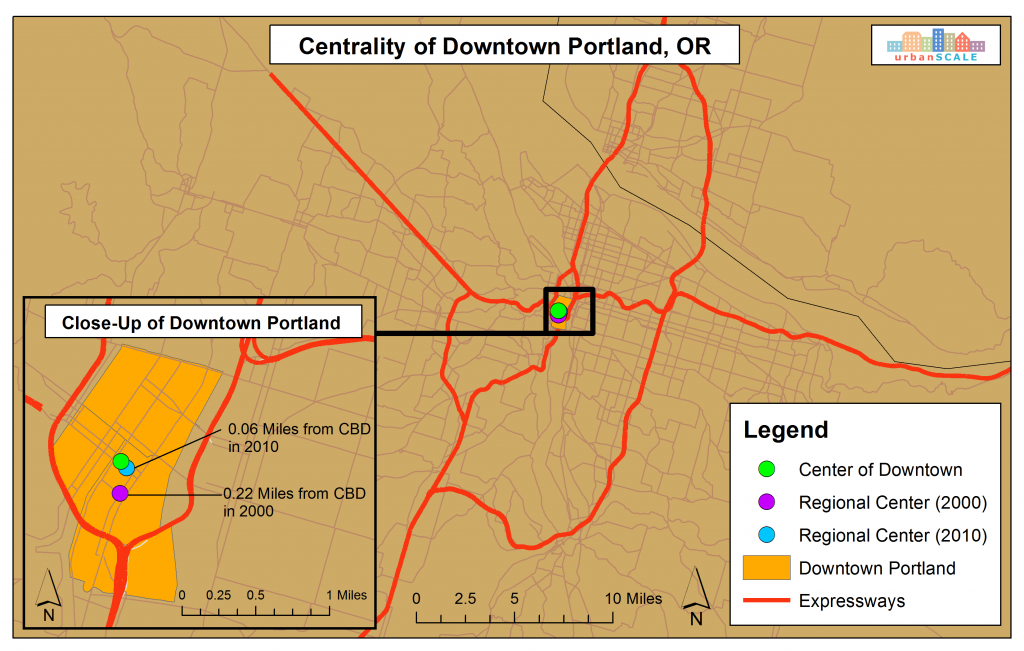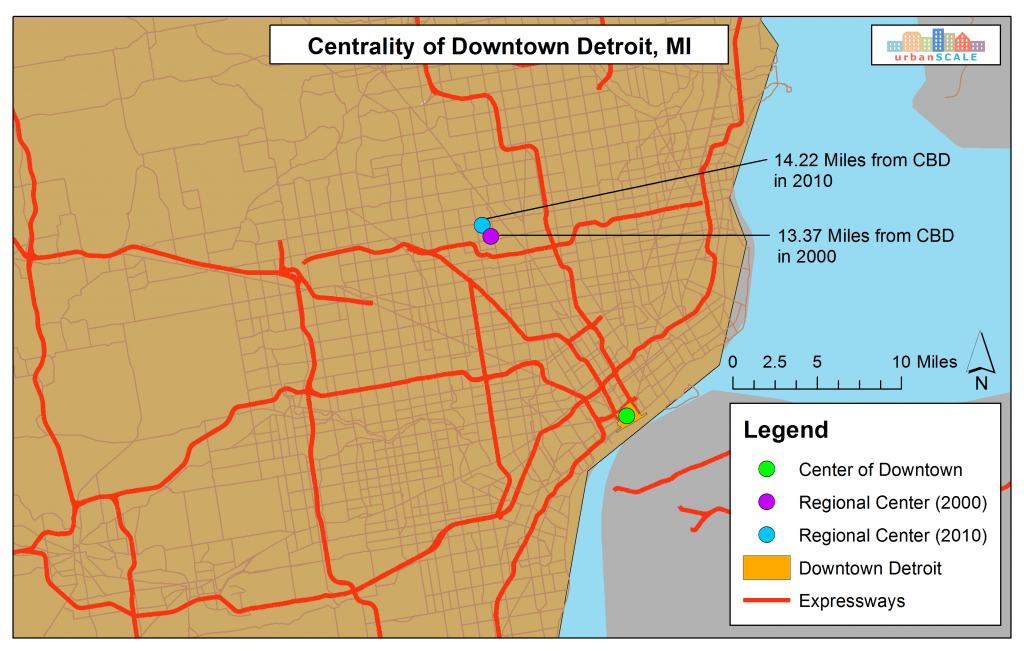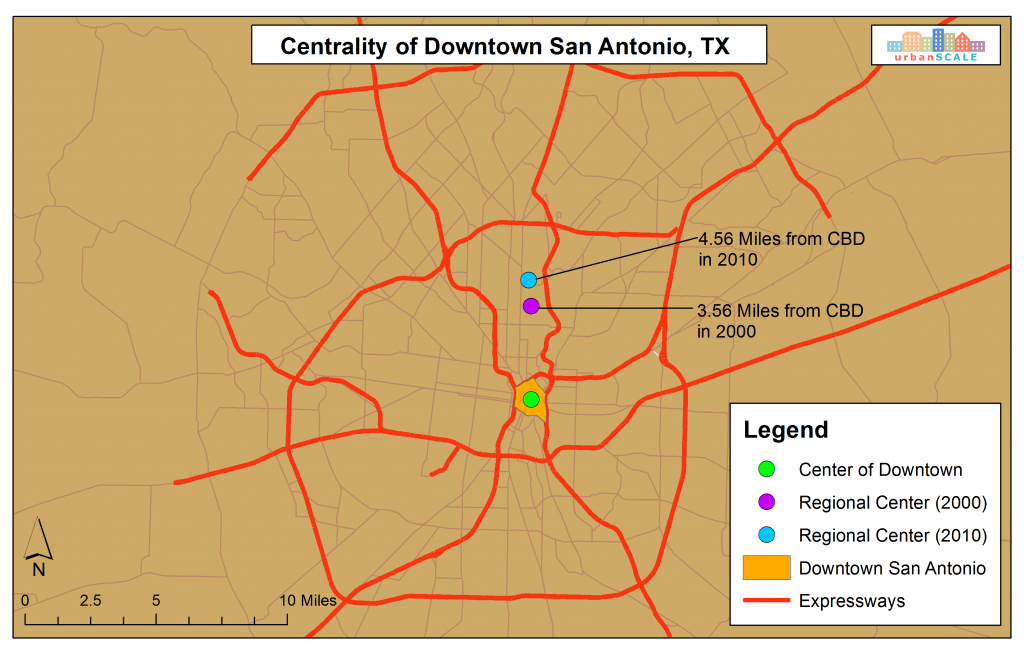This is the third in a series of three entries on thriving downtowns in the largest 100 U.S. cities. The first post here focused on growth rates of downtown population and jobs. The second post here also looked at the growth of downtown jobs and population in each city, but focused on absolute numbers instead of percentages. This post will focus on each downtown’s importance to its respective urban region.
In Part 1 and Part 2 of this blog series, we looked at growth rates of downtowns in the nation’s 100 largest cities. The big-picture growth trends are very positive overall, especially in the way of population growth. This post will help to answer the question: how important is a city’s downtown and its surrounding neighborhoods? We can measure each downtown’s importance by looking at seven variables:
- Distance from Central Business District (CBD) to Region’s Center of Gravity
- Percent of Region’s Jobs in CBD (2011)
- Percent of Region’s Jobs in CBD + 1-Mile Radius (2002-2011)
- Percent of Region’s Jobs in CBD + 3-Mile Radius (2002-2011)
- Percent of Region’s Population in CBD (2010)
- Percent of Region’s Population in CBD + 1-Mile Radius (2010)
- Percent of Region’s Population in CBD + 3-Mile Radius (2010)
If you are itching to see the raw data, take a look at the table at the end of this blog post. If you can wait a few minutes, or if you want me to first explain why any of this data matters, read on!
How Centrally Located Is Your City’s Downtown?
Have you ever taken a minute to wonder about the exact location of the center of your metro area? If your like most people, probably not. Many people believe that the region’s downtown is the center of the region. And many more people simply have not thought about this at all.
The funny thing is, despite sounding like a purely academic concept, the location of a metro area’s center of gravity – its mean center of population in more formal terms – has huge implications in the real world. More specifically, where a region’s center of gravity is in relation to that region’s CBD has a big impact on the success of that region’s downtown and for the urban vitality of the entire region.
It is also important to know how a metro area’s center of gravity is changing over time. In other words, is the region growing towards or away from its downtown? The best way to begin explaining this is with a couple of maps. We will start in Portland, Oregon.

Portland, Oregon has the most centrally located downtown in America. If you stand at the center of downtown Portland, you are literally one football field away from the exact center of the entire Portland-Vancouver-Hillsboro metropolitan region. Downtown Portland is closer to its regional center of gravity than any other big city in the U.S. In fact, most downtowns are several miles or more from the center of their region (for the 100 largest U.S. cities, the average distance from the city’s CBD to the region’s center of gravity is 7.1 miles). The central location of Portland’s downtown is one of the reasons behind its success as a vibrant urban district.
Now, let’s take a look at Detroit, Michigan’s downtown in relation to its regional center of gravity.

Detroit’s CBD is more than 14 miles away from the region’s center of gravity. And the Detroit region is growing farther away from downtown (the distance increased by 0.85 miles from 2000 to 2010). Downtown Detroit’s increasing distance from the true center of the Detroit region is one of the factors that has contributed to the city’s gradual decline in urban vitality over the last few decades.
This is not meant to single out Detroit. The unfortunate truth is that most U.S. cities are growing away from their downtowns. In only 26 of the nation’s largest 100 cities, is the regional center of gravity shifting towards the downtown.
This is a challenge faced by many cities in their quest to improve the urban vitality of their downtown, and ultimately, to make their entire city more vibrant. Now, let’s take a look at why downtown centrality is so important and what can be done to improve it.
Change the Location of Your Downtown
The closer a region’s downtown is to that region’s center of gravity, the more that region’s downtown functions like the focal point of that region. Centrally located downtowns can more easily:
- Create and sustain efficient transit systems;
- Improve regional workforce access (benefiting employers and employees alike);
- Support a wide range of retail and service businesses; and
- Become thriving urban districts
Every urban region should prioritize efforts to improve the centrality of their downtown. You might say: “That’s crazy! I can’t just pick up my city’s downtown and move it north 6.5 miles to the center of the metro area!” That’s not what I’m saying. There are two ways to make your city’s downtown more centrally located over time:
- Strengthen your city’s downtown and surrounding neighborhoods
- Encourage balanced growth in your metro area, prioritizing growth patterns that move the region’s center toward the CBD
This is simple, but not easy. Take a look at San Antonio as an example. Back in 2003, visionary mayor Ed Garza (an urban planner by training) started the CitySouth initiative. CitySouth is a program to create more growth on the city’s south side, to counterbalance the high growth of San Antonio’s north side that had taken place for decades and led to its downtown no longer being centrally located. Hopes were high for the success CitySouth. With a new major Toyota manufacturing plant and a new Texas A&M-San Antonio university campus, many observers thought the days of San Antonio’s unbalanced growth were numbered.
Now, let’s fast-forward a decade later. Today, we can see that CitySouth has hardly captured any of the region’s growth. Meanwhile, the San Antonio-New Braunfels metro area gained more than 400,000 new residents since 2000, and the vast majority of that growth took place north of downtown San Antonio. In fact, the region’s center of gravity moved north another mile between 2000 and 2010, as you can see in the map below.

Many observers blame restrictive regulations on CitySouth’s slow development, but the real lesson is that it is just plain difficult to change a pattern of city growth that has taken place for decades, even when that growth pattern is clearly harming downtown. It will take continued strategic efforts and many years for San Antonio to realize a more balanced growth pattern and hopefully, a more centrally located downtown. This is a challenge that many cities face. And this challenge is much bigger and much more important for large urban regions for two reasons:
- It takes much more (more effort, more development, more time) to shift the center of a metro area of 5,000,000 residents than a metro area of 500,000 residents.
- Small metro areas are generally much more compact than large metro areas. This means that even if a small region’s CBD is not centrally located, it still might be easily accessible for most residents. Boise, Idaho is a good example of this. Downtown Boise is at the eastern edge of its metro area (9.4 miles from the regional center of gravity), but is still relatively accessible because of the region’s small size. Of course, as Boise continues to grow, the centrality of its downtown will become more important.
Compactness is one of the advantages in smaller urban regions compared to large metro areas. The following table with the Top 10 most centrally located downtowns among the 100 largest U.S. cities highlights this advantage. Of the 10 cities, only 2 (Portland and Baltimore) are in regions with a population above 2,000,000.
Top 10 Most Centrally Located Downtowns
| Rank | City | State | Miles from CBD to Regional Center of Gravity (2010) |
| 1 | Portland | OR | 0.06 |
| 2 | Baltimore | MD | 0.59 |
| 3 | Tucson | AZ | 0.6 |
| 4 | Lincoln | NE | 0.64 |
| 5 | Fort Wayne | IND | 0.82 |
| 6 | Lexington | KY | 1.09 |
| 7 | Raleigh | NC | 1.35 |
| 8 | Fresno | CA | 1.37 |
| 9 | Indianapolis | IN | 1.39 |
| 10 | Reno | NV | 1.52 |
Is Your City’s Downtown More Important Than Midtown Manhattan?
How important is your city’s downtown? This may seem like a loaded question. Of course, the CBDs of New York and Chicago are more important to the national economy than any other downtown. But that is not what we are talking about here. We should reframe the question to ask: How important is your city’s downtown to your metro area? This changes things a lot. Midtown Manhattan may be the biggest and most important CBD in North America, but did you know that downtown Austin, downtown Honolulu, and downtown Anchorage are more important to their respective region? The truth is that many cities have downtowns play a bigger relative role in the success of their surrounding region. We can easily measure this role by comparing the percent of the metro area’s total jobs and population found within the city’s downtown and surrounding neighborhoods. Take a look at the following table, which lists the Top 10 downtowns of the largest 100 U.S. cities by the percentage of the region’s jobs that are found within those downtowns.
Top 10 Downtowns Ranked By Percent Region’s Jobs
| Rank | City | State | Percent of Region’s Jobs in CBD (2011) |
| 1 | Honolulu | HI | 17.4% |
| 2 | Austin | TX | 14.4% |
| 3 | Chicago | IL | 14.4% |
| 4 | Indianapolis | IN | 13.6% |
| 5 | Anchorage | AK | 13.4% |
| 6 | Boise | ID | 12.8% |
| 7 | Birmingham | AL | 12.8% |
| 8 | Jacksonville | FL | 12.8% |
| 9 | Washington | DC | 12.7% |
| 10 | Corpus Christi | TX | 12.0% |
This is actually a perfect stopping point since I began this three-part blog series by making the claim that downtowns are the most important part of cities, and we are now ending this post by looking at some hard numbers that support this claim. I’d love to hear your thoughts. How important is your city’s downtown? How important is downtown to your organization? How important is downtown to you?
The Importance of Downtown in 100 Largest Cities*





This analysis makes me realize that the distance between a city’s central business district and the region’s center of gravity is a relationship which grows, changes, can be enhanced or deteriorate. For many cities, topographic limitations, building/zoning codes, and transportation are interconnected issues that must be dealt with for the relationship to improve. For example, cities founded on major waterways may have a very different 21st century dynamic than the founding fathers could have imagined, challenging future connectedness between the CBD and the region’s center of gravity.
Important point about the limitations faced by cities with large waterfronts. On the one hand, waterways and topographic limitations force cities to develop in a more dense manner which is a good thing. But certainly there are also major challenges for cities that sit next to oceans or large lakes. Take Chicago for instance. Unless someone decides to build a major island community in Lake Michigan to the east of downtown Chicago, there is no way for downtown Chicago to become the center of gravity of its surrounding region. However, this doesn’t necessarily spell doom for downtown Chicago. The city’s downtown is still in good position to remain as the region’s most important employment/entertainment zone thanks to the extensive regional transit system that is designed primarily to connect downtown with surrounding neighborhoods and cities. Of course, the region’s massive size and the increasing distance from downtown to the regional center of gravity will naturally pull some momentum away from downtown, particularly in the way of retail and corporate headquarters. This has already happened to a large extent in the zone surrounding O’Hare airport about 15 miles northwest of downtown Chicago.